St Peter’s Anglican Church,
Albert Street, Eastern Hill, Melbourne
1912 sold to St Paul's Anglican Church, Geelong
Second organ, B 1912 Norman & Beard, Norwich; broken up 1969-72;
parts to All Saints' Cathedral, Bathurst, NSW, St John's Church, Hobart and elsewhere.
3m, 27spst, 7c, tubpn.
Gt: 8.8.8.8.4.4.2.8. Sw: 16.8.8.8.8.4.4.2.III.8.8. Ch: 8.8.4.8. Ped: 16.16.8.16.
Present organ, B 1974 Geo Fincham & Sons. 2m, 27spst, 3c, tr.
Gt: 8.8.4.4.2- 2/3.2.2.1-3/5.IV.8.4. RP: 8.8.4.2.1-1/3.III.II.16.8. Ped: 16.8.4.III.16.8.4.
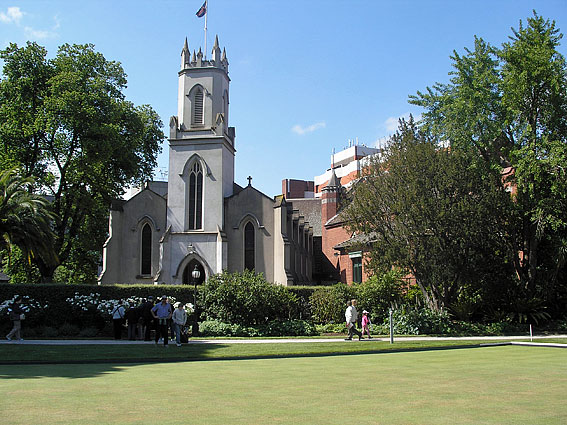
Photo: Simon Colvin
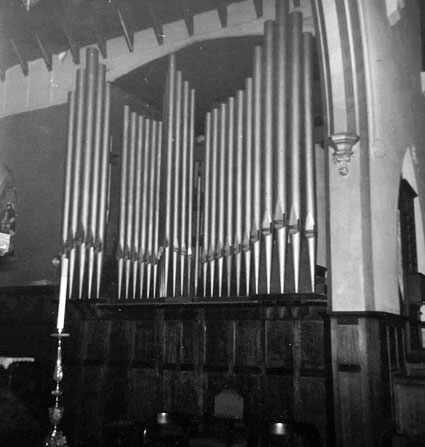
Case of the Norman & Beard organ 1960s (W.G.S. Smith)
The foundation stone of St Peter’s Church was laid on 16 June 1846 and the present nave and tower opened on 8 August 1848; the architect was Charles Laing. The transepts, chancel and additional bay to the nave, designed by Charles Vickers, were opened on 8 July 1854. The apsidal sanctuary, vestry and organ chamber were opened on St Peter’s Day 1876. This is the earliest Anglican church to survive in central Melbourne and of interest for its western tower, buttressed nave, finished externally in stucco, and the bluestone transepts and sanctuary. The interior contains many precious fittings, especially the lectern carved by Robert Prenzel and the high altar with its splendidly embroidered frontals and mosaic of the Last Supper.
The first organ at St Peter’s was built by John Smith & Sons, of Bristol, England. It was erected in 1855 by Henry Smith, from the Bristol firm, who was at the time resident in Melbourne. This firm built a total of five instruments for Melbourne, with other organs in St Paul’s Church (on the site of the present Cathedral), the Atheneum Hall in Collins Street (later moved to Holy Trinity, East Melbourne and destroyed by fire) and in the residences of W.D. Dredge, Esq. (Organist of the Collins Street Chapel, Melbourne), and Robert Smith, Esq., St Kilda. The engagement of Smith and Sons may have been due to a connection with the first Lieutenant-Governor of Victoria, The Hon. Charles La Trobe and his family.
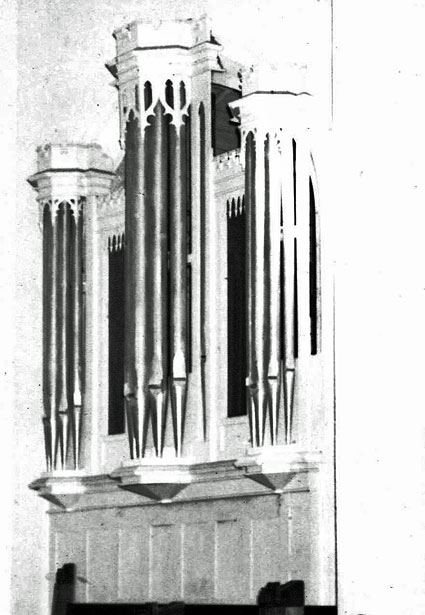
John Smith & Sons casework (taken at St Paul's Anglican Church, Geelong) (The Revd Robert Joyce)
This was a two-manual instrument of 17 speaking stops, a complete tonal design with chorus complete to Sesquialtera on the Great Organ, Swell with three reeds and an outstanding Gothic case where the central tower embodied a single pipe on either side of the five projecting pipes – a typical feature of a number of organs built in Bristol. The case was 10ft 7in wide, 11ft 9in deep and 17ft 6in high. The reed pipes were of fine spotted metal.
Originally placed in the rear gallery, it was later moved to the floor of the church and then to an organ chamber in 1876. George Fincham added a Dulciana stop to the Great Organ in 1893, Swell tremulant and two composition pedals.
| GREAT ORGAN Open Diapason Stop Diapason Bass Clarabella Viol di Gamba Principal Twelfth Fifteenth Sesquialtera Trumpet Swell to Great Organ SWELL ORGAN Open Diapason Stop Diapason Principal Twelfth Fifteenth Trumpet Hautboy Clarion PEDAL ORGAN Open Diapason Great to Pedals Swell to Pedals |
8 8 8 8 4 2-2/3 2 III 8 8 8 4 2-2/3 2 8 8 4 16 |
tone [CC-BB] [TC] [TC] [initially prepared-for] [originally to TC] tone |
Compass: 54/30
3 composition pedals to Great
Auxiliary bellows
Radiating pedals
Mechanical action
This instrument remained in the church until 1912 when it was sold to St Paul’s Anglican Church, Geelong. Here it was later electrified by Keith M. Lavers, and subsequently rebuilt and enlarged by Robert W. Elliston and Laurie Pipe Organs. Much of the Smith pipework survives, but the fine case was regrettably broken up in the mid-1960s.
A new organ was built for St Peter’s Church by the Norwich firm of Norman & Beard Ltd. This was one of the leading British organbuilders of the Edwardian period; the organist of St Peter’s Church, A.E.H. Nickson, had personal experience of its work at the Royal College of Organists, in Kensington Gore, London. It was the firm’s job number 1167 and cost £1,235. The organ was sited in a chamber to the south-east of the sanctuary. The quality of the pipework, mechanism and voicing was outstanding. Nickson delighted in the instrument and it was favourably remembered by his many pupils and provided a wonderful accompaniment to the Anglo-Catholic liturgy at St Peter’s Church.
The instrument was in poor mechanical shape by the 1960s and due for a full restoration. However, alterations were made to the pipework through transposition of existing material to form mutation registers. Finally, it was removed from the church in 1968 owing to a collapsing floor in the organ chamber. The pipework and chests were stored in the gallery of the parish hall, from where it never returned. When a neo-classical instrument was ordered from George Fincham & Sons Pty Ltd (opened in 1974) the Norman & Beard organ was broken up. The windchests and pipework were utilised in many other instruments. The right hand stop jamb and nameplate are in the possession of OHTA.
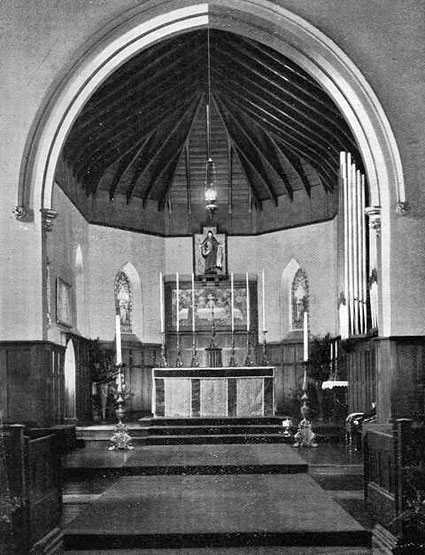
Sanctuary of St Peter's Church 1930s showing Norman & Beard organ case to right
(St Peter's Church, Eastern Hill, Melbourne) (John Maidment)
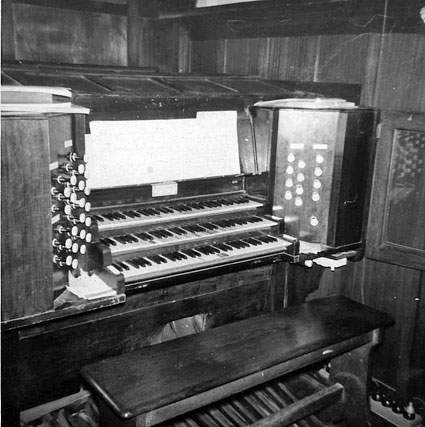
Console of the Norman & Beard organ 1960s (W.G.S. Smith)
| GREAT ORGAN Open Diapason Open Diapason Claribel Flute Dulciana Principal Harmonic Flute Fifteenth Trumpet Swell to Great Choir to Great SWELL ORGAN Bordun Open Diapason Lieblich Gedakt Salicional Voix Céleste Gemshorn Wald Flöte Flautina Mixture Horn Hautboy Tremulant Octave CHOIR ORGAN Hohl Flöte Viole d’Orchestre Lieblich Flöte Clarinet Tremulant Swell to Choir PEDAL ORGAN Open Diapason Bordun Violoncello Trombone Great to Pedal Swell to Pedal Choir to Pedal |
8 8 8 8 4 4 2 8 16 8 8 8 8 4 4 2 III 8 8 8 8 4 8 16 16 8 16 |
large medium wood wood wood BB flat wood (enclosed) wood wood wood |
Pedal compositions to Great
Compass: 61/30
Detached drawstop console
4 combination pedals to Great Organ to give appropriate Pedal stops by drawknob
4 combination pedals to Swell Organ
Reversible pedal for Great to Pedal
Balanced swell pedals for Swell and Choir Organs
Exhaust tubular-pneumatic action
The present organ in St Peter’s Church was built by George Fincham & Sons Pty Ltd to the designs of Sydney organist David Rumsey and opened on 31 March 1974. Placed in the rear gallery, it has two of the divisions (Hauptwerk and Pedal) placed in the main case and the Ruckpositiv divided in separate cases placed at the edge of the gallery. They key and stop actions are mechanical.
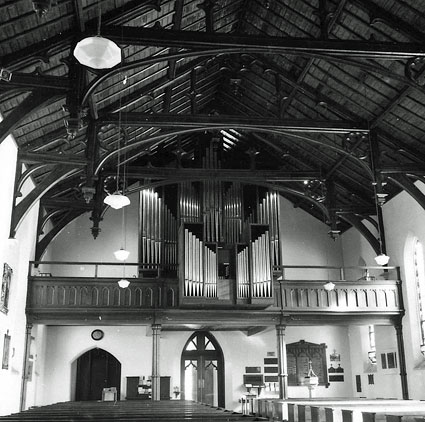
1974 organ by George Fincham & Sons Pty Ltd in rear gallery (John Maidment)
| HAUPTWERK Prinzipal Rohr Flöte Oktave Nachthorn Nasat Oktave Block Flöte Terz Mixtur IV Trompete Trompete Ruckpositiv to Hauptwerk RUCKPOSITIV Gedeckt Spitzgamba Rohr Flöte Prinzipal Quinte Terzsepta III # Scharff III Dulzian Krummhorn Tremulant PEDAL Subbass Flöten-Prinzipal Choral Bass MixtureIII Fagott Trompete Schalmey Hauptwerk to Pedal Ruckpositiv to Pedal |
8 8 4 4 2-2/3 2 2 1-3/5 1-1/3 8 4 8 8 4 2 1-1/3 2-2/3 1/2 16 8 16 8 4 2-2/3 16 8 4 |
(* = under expression) * * * # later converted to Sesquialtera 2-2/3 II * * |
Compass: 56/30
Wind pressures: Hauptwerk & Ruckpositiv 55 mm; Pedal 60 mm
E.N. Matthews, Colonial Organs and Organbuilders. Carlton: Melbourne University Press, 1969, p.116. Here the original organ is erroneously stated to have been built by William Hill.
John Smith & Sons specification from a leaflet in the St Peter’s archives. Cited in Geoffrey Cox, ‘The First Organ at St Peter’s Eastern Hill, Melbourne’, OHTA News vol 19, no 3 (July 1995), pp 18-19. See also part one of the article in OHTA News vol 19, no 2 (April 1995), pp22-37.
Norman & Beard specification noted John Maidment 1961 and further details from pamphlet The New Organ at St. Peter’s Church Melbourne (London: Norman & Beard Ltd, 1912).
Order number from a listing of Norman & Beard orders compiled by David Wickens.
David Rumsey, ‘The Organs of St Peter’s Anglican Church, Eastern Hill’ (part II), Victorian Organ Journal, vol 2, No 9 (July 1974), pp.3-7
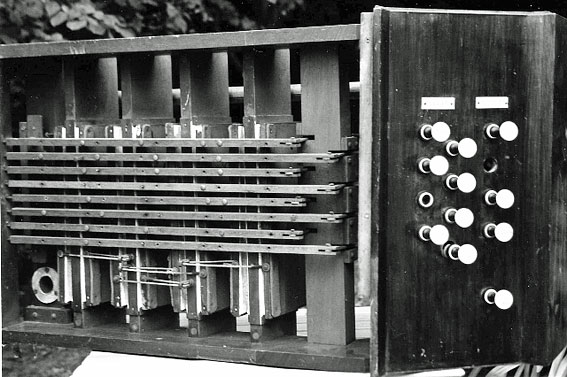
Norman & Beard right hand stop jamb (John Maidment)
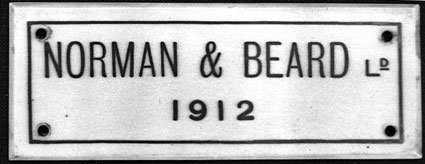
Norman & Beard nameplate (John Maidment)
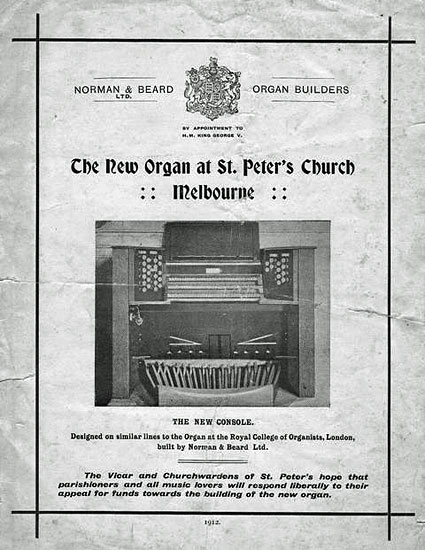
Norman & Beard pamphlet 1912 - page one (John Maidment)
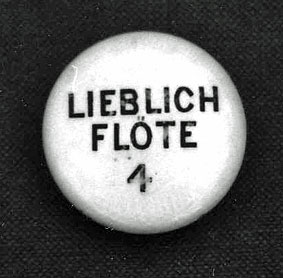
Norman & Beard Choir Lieblich Flote drawstop head (John Maidment)
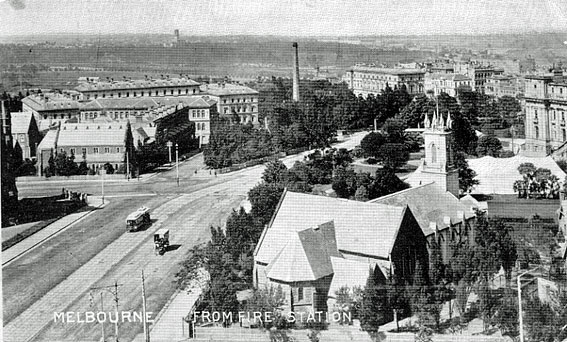
Postcard: Simon Colvin